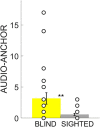Spatial Memory and Blindness: The Role of Visual Loss on the Exploration and Memorization of Spatialized Sounds
- PMID: 35686077
- PMCID: PMC9171105
- DOI: 10.3389/fpsyg.2022.784188
Spatial Memory and Blindness: The Role of Visual Loss on the Exploration and Memorization of Spatialized Sounds
Abstract
Spatial memory relies on encoding, storing, and retrieval of knowledge about objects' positions in their surrounding environment. Blind people have to rely on sensory modalities other than vision to memorize items that are spatially displaced, however, to date, very little is known about the influence of early visual deprivation on a person's ability to remember and process sound locations. To fill this gap, we tested sighted and congenitally blind adults and adolescents in an audio-spatial memory task inspired by the classical card game "Memory." In this research, subjects (blind, n = 12; sighted, n = 12) had to find pairs among sounds (i.e., animal calls) displaced on an audio-tactile device composed of loudspeakers covered by tactile sensors. To accomplish this task, participants had to remember the spatialized sounds' position and develop a proper mental spatial representation of their locations. The test was divided into two experimental conditions of increasing difficulty dependent on the number of sounds to be remembered (8 vs. 24). Results showed that sighted participants outperformed blind participants in both conditions. Findings were discussed considering the crucial role of visual experience in properly manipulating auditory spatial representations, particularly in relation to the ability to explore complex acoustic configurations.
Keywords: acoustic perception; audio-spatial skills; blindness; development; user-friendly technologies; working memory.
Copyright © 2022 Setti, Cuturi, Cocchi and Gori.
Conflict of interest statement
The authors declare that the research was conducted in the absence of any commercial or financial relationships that could be construed as a potential conflict of interest.
Figures







Similar articles
-
A novel paradigm to study spatial memory skills in blind individuals through the auditory modality.Sci Rep. 2018 Sep 6;8(1):13393. doi: 10.1038/s41598-018-31588-y. Sci Rep. 2018. PMID: 30190584 Free PMC article. Clinical Trial.
-
Audio drawing and working memory in blindness: design, development and validation of a multi-sensory system.Annu Int Conf IEEE Eng Med Biol Soc. 2022 Jul;2022:777-780. doi: 10.1109/EMBC48229.2022.9871881. Annu Int Conf IEEE Eng Med Biol Soc. 2022. PMID: 36085611
-
Spatial imagery relies on a sensory independent, though sensory sensitive, functional organization within the parietal cortex: a fMRI study of angle discrimination in sighted and congenitally blind individuals.Neuropsychologia. 2015 Feb;68:59-70. doi: 10.1016/j.neuropsychologia.2015.01.004. Epub 2015 Jan 6. Neuropsychologia. 2015. PMID: 25575449
-
Verbal and Spatial Working Memory Capacity in Blind Adults and the Possible Influence of Age at Blindness Onset: A Systematic Review and Meta-analysis.Neuropsychol Rev. 2024 Oct 14. doi: 10.1007/s11065-024-09651-5. Online ahead of print. Neuropsychol Rev. 2024. PMID: 39397144 Review.
-
Spatial Knowledge via Auditory Information for Blind Individuals: Spatial Cognition Studies and the Use of Audio-VR.Sensors (Basel). 2022 Jun 24;22(13):4794. doi: 10.3390/s22134794. Sensors (Basel). 2022. PMID: 35808291 Free PMC article. Review.
Cited by
-
A Technology Aid to Help People with Blindness and Moderate Intellectual Disability Retrieve Common Objects from Storage Units: A Proof-of-Concept Study.Sensors (Basel). 2024 Jul 10;24(14):4453. doi: 10.3390/s24144453. Sensors (Basel). 2024. PMID: 39065851 Free PMC article.
References
-
- Arditi R., Dacorogna B. (1988). Optimal foraging on arbitrary food distributions and the definition of habitat patches. Am. Natural. 1988:284825. 10.1086/284825 - DOI
LinkOut - more resources
Full Text Sources
Miscellaneous

